Rectum
- "Rectal" redirects here. For the route of administration, see Rectal (medicine).
- For the conic sections see Latus rectum or Semi-latus rectum
| Rectum |
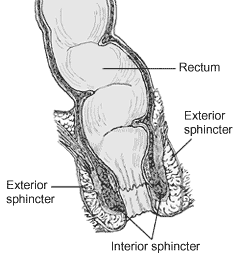 |
| Anatomy of the anus and rectum |
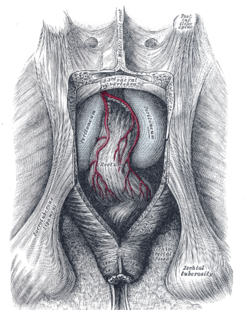 |
| Posterior aspect of rectum exposed by removing lower part of sacrum and coccyx |
| Gray's |
subject #249 1183 |
| Artery |
superior rectal artery (first two-thirds of rectum), middle rectal artery (last third of rectum) |
| Vein |
superior rectal veins, middle rectal veins |
| Nerve |
inferior anal nerves, inferior mesenteric ganglia[1] |
| Lymph |
inferior mesenteric lymph nodes, pararectal lymph nodes, internal iliac lymph nodes |
| Precursor |
Hindgut |
| MeSH |
Rectum |
The rectum (from the Latin rectum intestinum, meaning straight intestine) is the final straight portion of the large intestine in some mammals, and the gut in others, terminating in the anus. The human rectum is about 12 cm long. Its caliber is similar to that of the sigmoid colon at its commencement, but it is dilated near its termination, forming the rectal ampulla.
Role in human defecation
The rectum intestinum acts as a temporary storage site for feces. As the rectal walls expand due to the materials filling it from within, stretch receptors from the nervous system located in the rectal walls stimulate the desire to defecate. If the urge is not acted upon, the material in the rectum is often returned to the colon where more water is absorbed. If defecation is delayed for a prolonged period, constipation and hardened feces results.
When the rectum becomes full, the increase in intrarectal pressure forces the walls of the anal canal apart, allowing the fecal matter to enter the canal. The rectum shortens as material is forced into the anal canal and peristaltic waves propel the feces out of the rectum. The internal and external sphincter allow the feces to be passed by muscles pulling the anus up over the exiting feces.
Supports of rectum
- Pelvic floor formed by levator ani muscles.
- Fascia of Waldeyer
- Lateral ligaments of rectum which are formed by the condensation of pelvic fascia
- Rectovesical fascia of Denonvillers, which extends from rectum behind to the seminal vesicles and prostate in front.
- Pelvic peritoneum
- Perineal body
Medical procedures
For the diagnosis of certain ailments, a rectal exam may be done.
Suppositories may be inserted into the rectum as a route of administration for medicine.
The endoscopic procedures colonoscopy and sigmoidoscopy are performed to diagnose diseases such as cancer.
Digital Rectal Stimulation, the insertion of one finger into the rectum, is used to induce peristalsis in patients whose own peristaltic reflex is inadequate to fully empty the rectum.
Manual Evacuation is the use of a gloved finger to evacuate faeces from the rectum, and is utilised primarily in acute constipation and also the long-term management of neurogenic bowel, seen most frequently in people with a spinal cord injury or multiple sclerosis.
Temperature taking
Body temperature can also be taken in the rectum. Rectal temperature can be taken by inserting a medical thermometer not more than 25 mm (1 inch) into the rectum via the anus. A mercury thermometer should be inserted for 3 to 5 minutes; a digital thermometer should remain inserted until it beeps. Due to recent concerns related to mercury poisoning, the use of mercury thermometers is outlawed. Normal rectal temperature generally ranges from 36 to 38 °C (97.6 to 100.4 °F) and is about 0.5 °C (1 °F) above oral (mouth) temperature and about 1 °C (2 °F) above axilla (armpit) temperature.
Many pediatricians recommend that parents take infants' and toddlers' temperature in the rectum for two reasons:
- Rectal temperature is the closest to core body temperature and in young children, accuracy is critical.
- Younger children are unable to cooperate when having their temperature taken by mouth (oral), which is recommended for children ages 6 and above as well as adults.
In recent years, the introduction of tympanic (ear) thermometers and changing attitudes on privacy and modesty have led some parents and doctors to discontinue taking rectal temperatures.
Sexual stimulation
Due to the proximity of the anterior wall of the rectum to the vagina in females or to the prostate in males and the shared nerves thereof, rectal stimulation or penetration can result in sexual arousal. For further information on this aspect, see anal sex.
Additional images
|
|
|
Median sagittal section of male pelvis, showing arrangement of fasciæ
|
|
|
|
Median sagittal section of male pelvis
|
|
|
|
Median sagittal section of female pelvis
|
|
|
|
Sagittal section of the lower part of a female trunk, right segment
|
|
|
|
Cross-section microscopic shot of the rectal wall
|
|
|
|
Section of mucous membrane of human rectum (60×)
|
|
|
|
Dog Rectum cross-section (40×)
|
|
|
|
Dog Rectum cross-section (400×)
|
|
See also
References
External links
|
Human systems and organs |
|
TA 2-4:
MS |
|
|
|
|
|
|
Fibrous joint · Cartilaginous joint · Synovial joint
|
|
|
|
|
|
|
TA 5-11:
splanchnic/
viscus |
|
mostly
Thoracic
|
|
|
|
mostly
Abdominopelvic
|
|
|
Mouth ( Salivary gland, Tongue) · upper GI ( Oropharynx, Laryngopharynx, Esophagus, Stomach) · lower GI ( Small intestine, Appendix, Colon, Rectum, Anus) · accessory ( Liver, Biliary tract, Pancreas)
|
|
|
|
|
|
|
|
|
|
|
|
|
|
|
|
| TA 12-16 |
|
|
Blood
(Non-TA) |
|
|
| general anatomy: systems and organs, regional anatomy, , , superficial anatomy of limbs |
|
|
Anatomy of torso, digestive system: Gastrointestinal tract, excluding mouth (TA A05.3-7, GA 11.1141) |
|
| Upper GI |
|
|
Piriform sinus
spaces: Peripharyngeal space (Retropharyngeal space, Parapharyngeal space) · Retrovisceral space (Retropharyngeal space, Danger space) · Prevertebral space
Pterygomandibular raphe · Pharyngeal raphe · Buccopharyngeal fascia · Pharyngobasilar fascia
Pharyngeal muscles
|
|
|
|
UES · LES · Esophageal glands
Serosa / Adventitia · Muscular layer · Submucosa · Mucosa (Muscularis mucosa)
|
|
|
|
by region: Greater curvature · Lesser curvature (Angular incisure) · Cardia · Body · Fundus · Pylorus (Pyloric antrum, Pyloric canal)
by layer: Serosa · Muscular layer (Pyloric sphincter) · Submucosa · Gastric mucosa (Muscularis mucosa, Gastric rugae, Gastric pits, Gastric gland/Cardiac glands/Fundic glands/Pyloric glands)
|
|
|
| Lower GI |
|
|
|
Layers
|
Serosa · Subserosa · Muscular layer · Circular folds · Submucosa · Mucosa (Muscularis mucosa, Peyer's patches, Intestinal villus, Intestinal gland) |
|
|
|
Suspensory muscle, Major duodenal papilla, Minor duodenal papilla, Duodenal cap • Duodenojejunal flexure • Brunner's glands
|
|
|
|
no substructures
|
|
|
Ileum
|
Terminal ileum • Ileocecal valve
|
|
|
|
|
|
Layers
|
Serosa · Subserosa · Muscular layer · Submucosa · Mucosa |
|
|
Cecum
|
|
|
|
|
ascending colon, hepatic flexure, transverse colon, splenic flexure, descending colon, sigmoid colon
continuous (taenia coli, haustra, epiploic appendix)
|
|
|
Rectum
|
Transverse folds of rectum • Rectal ampulla
|
|
|
Anal canal
|
Anal columns • Anal valves • Anal sinuses • Pectinate line
Sphincter ani internus muscle • Intersphincteric groove • Sphincter ani externus muscle
Anus
|
|
|
|
|
|
anat(t, g, p)/phys/devp/cell/
|
|
proc, drug(A2A/2B/3/4//6/7/14/16), blte
|
|
|
|
|
Routes of administration / Dosage forms |
|
| Oral |
|
|
|
|
Pill · Tablet · Capsule · Osmotic controlled release capsule (OROS) · Softgel
|
|
|
|
|
|
|
|
Buccal / Sublabial / Sublingual
|
|
|
Orally Disintegrating Tablet (ODT) · Film · Lollipop · Lozenges · Chewing gum
|
|
|
|
|
|
|
|
Respiratory tract
|
|
|
|
|
|
|
pressurized Metered Dose Inhaler (pMDI) · Nebulizer · Vaporizer
|
|
|
|
Oxygen mask · Oxygen concentrator · Anaesthetic machine · Relative analgesia machine
|
|
|

-solution.jpg)




 |
|
| Ocular / Otologic / Nasal |
Nasal spray · Ear drops · Eye drops · Ointment · Hydrogel · Nanosphere suspension · Mucoadhesive microdisc (microsphere tablet) |
|
| Urogenital |
Ointment · Pessary (vaginal suppository) · Vaginal ring · Vaginal douche · Intrauterine device (IUD) · Extra-amniotic infusion · Intravesical infusion
|
|
| Rectal (enteral) |
|
|
| Dermal |
Ointment · Liniment · Paste · Film · Hydrogel · Liposomes · Transfersome vesicals · Cream · Lotion · Lip balm · Medicated shampoo · Dermal patch · Transdermal patch · Transdermal spray · Jet injector
|
|
Injection / Infusion
(into tissue/blood) |
|
Skin
|
|
|
|
|
Intracavernous · Intravitreal · Transscleral
|
|
|
|
|
|
|
|
Intravenous · Intracardiac · Intramuscular · Intraosseous · Intraperitoneal · Nanocell injection
|
|
|
| Additional explanation: |
Mucous membranes are used by the human body to absorb the dosage for all routes of administration, except for "Dermal" and "Injection/Infusion".
Administration routes can also be grouped as Topical (local effect) or Systemic (defined as Enteral = Digestive tract/Rectal, or Parenteral = All other routes).
|
|
|



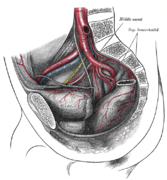
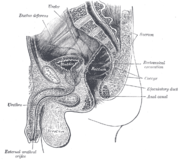
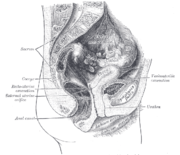
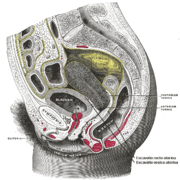
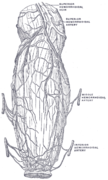
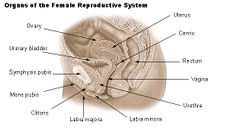



-solution.jpg)

